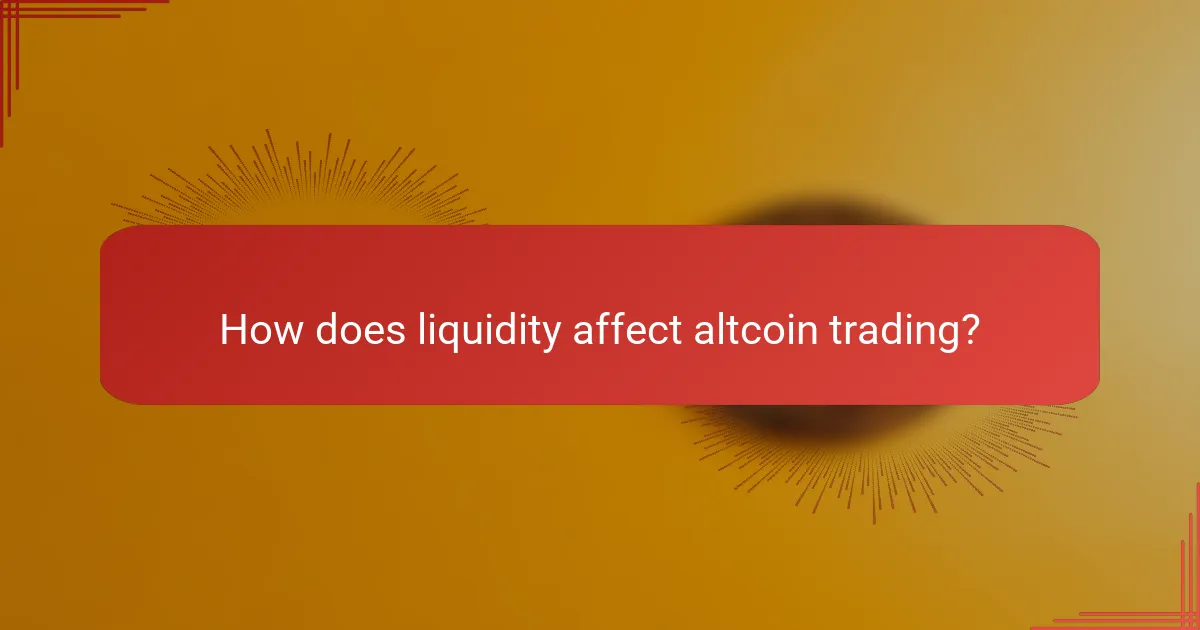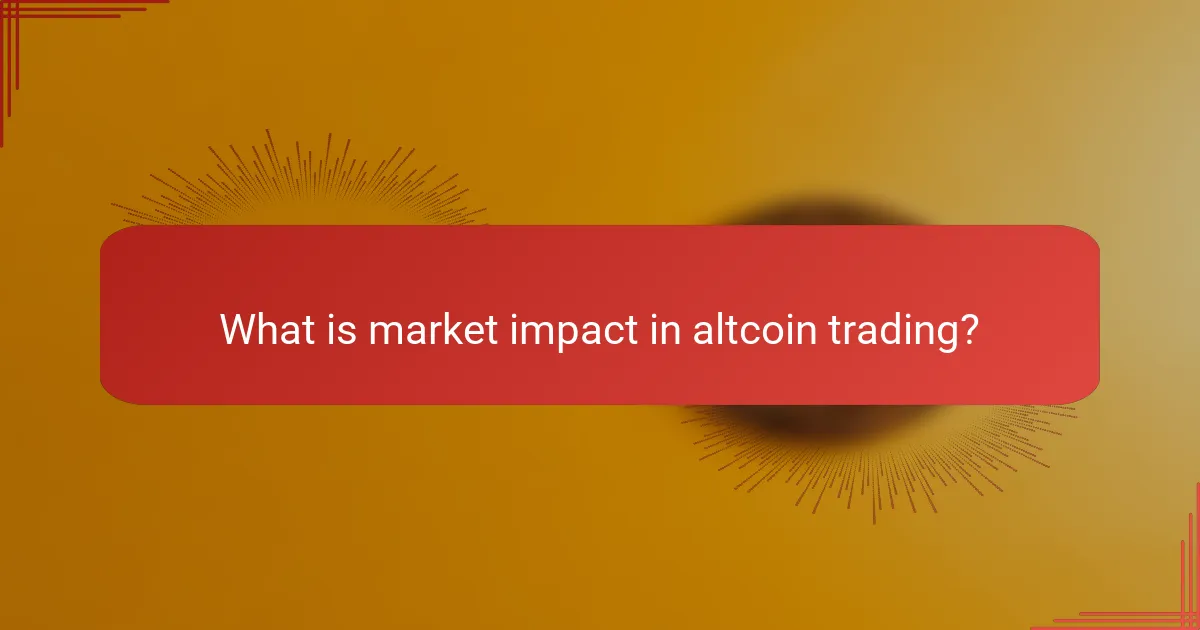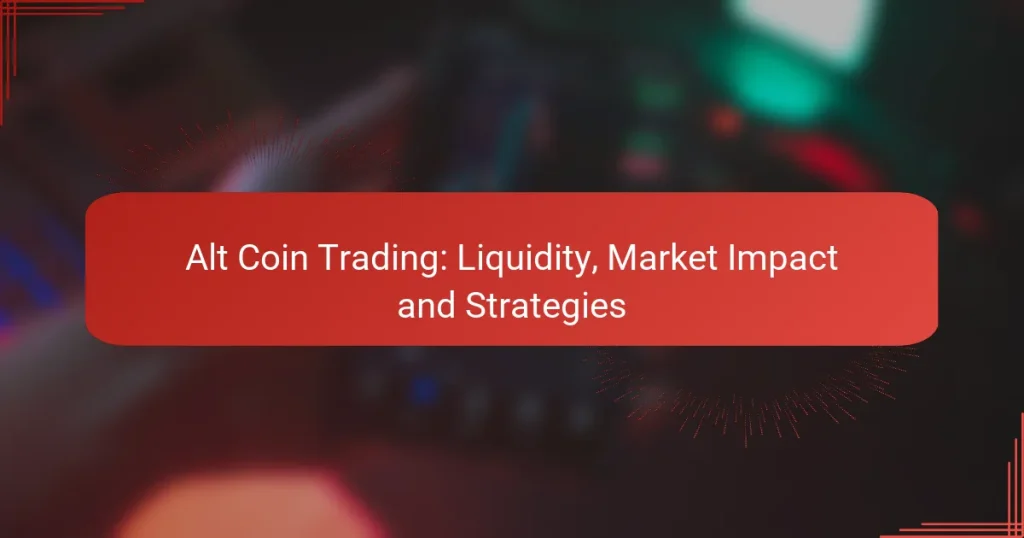Altcoin trading involves navigating a complex landscape where liquidity and market impact play crucial roles in determining trading success. High liquidity facilitates quick transactions, while low liquidity can lead to volatile price movements. Understanding how market orders influence prices is essential for traders, as large trades can significantly affect the overall trading environment. By employing effective strategies such as scalping, HODLing, and arbitrage, traders can better align their approaches with their goals and the prevailing market conditions.

How does liquidity affect altcoin trading?
Liquidity significantly impacts altcoin trading by determining how easily assets can be bought or sold without affecting their price. High liquidity allows for swift transactions, while low liquidity can lead to larger price swings and increased risk for traders.
High liquidity enables faster transactions
High liquidity in altcoin markets means that there are many buyers and sellers available, facilitating quick trades. This environment allows traders to execute orders almost instantly, often within seconds, minimizing slippage and ensuring that the price at which they buy or sell closely matches the market price.
For example, major altcoins like Ethereum or Litecoin typically exhibit high liquidity, enabling traders to enter or exit positions rapidly. This is particularly beneficial during volatile market conditions when timing can significantly impact profitability.
Low liquidity increases price volatility
Low liquidity can lead to significant price volatility in altcoin trading. When there are fewer participants in the market, even small trades can cause large price fluctuations, making it riskier for traders. This volatility can be particularly pronounced in lesser-known altcoins, where a single buy or sell order can dramatically shift the market price.
Traders should be cautious when dealing with low-liquidity altcoins, as the potential for rapid price changes can result in unexpected losses. It’s advisable to monitor trading volumes and avoid placing large orders that could exacerbate price swings.
Impact on trading strategies
The level of liquidity directly influences trading strategies. In high-liquidity environments, traders can employ strategies like scalping, which relies on making small profits from numerous trades. Conversely, in low-liquidity markets, strategies may need to focus on longer-term positions to mitigate the risks associated with price volatility.
Traders should consider liquidity when setting stop-loss orders or taking profits, as these strategies may need adjustment based on market conditions. For instance, in low-liquidity situations, wider stop-loss orders may be necessary to avoid being stopped out by normal price fluctuations.

What is market impact in altcoin trading?
Market impact in altcoin trading refers to the effect that a trader’s buy or sell orders have on the price of an altcoin. When large orders are placed, they can significantly shift market prices, affecting the overall liquidity and trading environment.
Definition of market impact
Market impact is defined as the change in the price of an asset resulting from a specific trade or series of trades. In altcoin trading, this impact can vary based on the size of the order relative to the market’s liquidity. A larger order typically results in a more pronounced price change.
Traders must understand that market impact can lead to slippage, where the execution price differs from the expected price due to the order’s effect on market dynamics.
Factors influencing market impact
Additionally, the time of day can affect market impact. Trading during peak hours often results in lower impact due to higher trading volumes, while off-peak hours may see more significant price shifts from large orders.
Examples of market impact

What are effective trading strategies for altcoins?
Effective trading strategies for altcoins include scalping, HODLing, and arbitrage. Each approach has its own risk profile and potential rewards, making it essential for traders to choose a strategy that aligns with their goals and market conditions.
Scalping strategies
Scalping involves making numerous trades throughout the day to capitalize on small price movements. Traders typically hold positions for a few seconds to minutes, aiming to profit from minor fluctuations in the market.
To implement a scalping strategy, traders should focus on high liquidity altcoins to ensure quick entry and exit. Utilizing technical analysis tools, such as moving averages and volume indicators, can help identify optimal trading opportunities.
Common pitfalls include overtrading and neglecting transaction fees, which can erode profits. Setting strict risk management rules, like stop-loss orders, is crucial to protect against significant losses.
HODLing approach
The HODLing strategy involves buying altcoins and holding them for an extended period, regardless of market volatility. This approach is based on the belief that the value of the asset will increase significantly over time.
Investors should conduct thorough research to select promising altcoins with strong fundamentals and potential for growth. A diversified portfolio can help mitigate risks associated with market fluctuations.
While HODLing can lead to substantial gains, it requires patience and a strong conviction in the chosen assets. Traders should be prepared for market downturns and avoid panic selling during price dips.
Arbitrage opportunities
Arbitrage involves exploiting price differences of the same altcoin across different exchanges. Traders buy the asset at a lower price on one platform and sell it at a higher price on another, profiting from the discrepancy.
To effectively pursue arbitrage, traders need to monitor multiple exchanges and act quickly, as price differences can close rapidly. Utilizing automated trading bots can enhance efficiency and speed in executing trades.
However, transaction fees and withdrawal limits can impact profitability, so it’s essential to factor these costs into calculations. Staying informed about market conditions and exchange regulations is also crucial to avoid potential pitfalls.

How to assess liquidity in altcoin markets?
To assess liquidity in altcoin markets, traders should evaluate trading volume, order book depth, and the reputation of exchanges. These factors help determine how easily an altcoin can be bought or sold without significantly affecting its price.
Using trading volume metrics
Trading volume is a key indicator of liquidity, reflecting the total amount of an altcoin traded over a specific period. High trading volumes generally indicate better liquidity, allowing for quicker transactions with minimal price impact. Look for altcoins with daily trading volumes in the low millions to ensure sufficient market activity.
When analyzing volume, consider both absolute figures and trends over time. A sudden spike in volume can signal increased interest, but it may also indicate volatility. Regularly monitor volume patterns to identify stable altcoins versus those that may experience erratic trading behavior.
Analyzing order book depth
Order book depth provides insight into the number of buy and sell orders at various price levels. A deeper order book, with numerous orders close to the current market price, suggests better liquidity. This means larger trades can be executed without significantly moving the market price.
To assess order book depth, examine the spread between the highest bid and lowest ask prices. A narrower spread typically indicates higher liquidity. Additionally, check the cumulative volume of orders at the top levels; a strong presence of orders can help mitigate slippage during trades.
Evaluating exchange reputation
The reputation of the exchange where an altcoin is traded plays a crucial role in its liquidity. Well-established exchanges tend to have higher trading volumes and better security measures, which attract more traders. Look for exchanges with a strong track record and positive user reviews.
Consider factors such as regulatory compliance, user experience, and the range of trading pairs offered. Exchanges that are regulated or have a transparent operational history often provide a safer trading environment, enhancing overall liquidity in the altcoin market.

What are the prerequisites for successful altcoin trading?
Successful altcoin trading requires a solid understanding of the market, effective risk management, and a well-defined strategy. Traders should be prepared to analyze market trends, assess liquidity, and implement techniques to mitigate potential losses.
Understanding market trends
Recognizing market trends is crucial for altcoin trading. Traders should familiarize themselves with both bullish and bearish patterns, as these can indicate potential price movements. Utilizing tools like moving averages and trend lines can help identify these patterns effectively.
Additionally, staying informed about news and events that may impact the cryptocurrency market is essential. For instance, regulatory changes or technological advancements can significantly influence altcoin prices. Regularly reviewing market sentiment through social media and forums can also provide valuable insights.
Risk management techniques
Implementing robust risk management techniques is vital for minimizing losses in altcoin trading. Traders should consider setting stop-loss orders to automatically sell assets when they reach a predetermined price, thus limiting potential losses. A common recommendation is to risk only a small percentage of your total capital on any single trade.
Diversification is another effective strategy. By spreading investments across multiple altcoins, traders can reduce the impact of a poor-performing asset on their overall portfolio. It’s also wise to regularly review and adjust your risk management strategies based on market conditions and personal trading performance.


